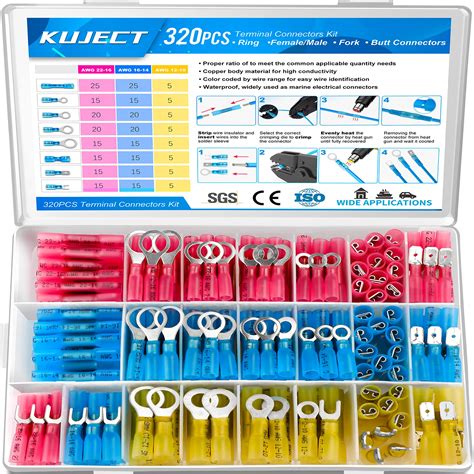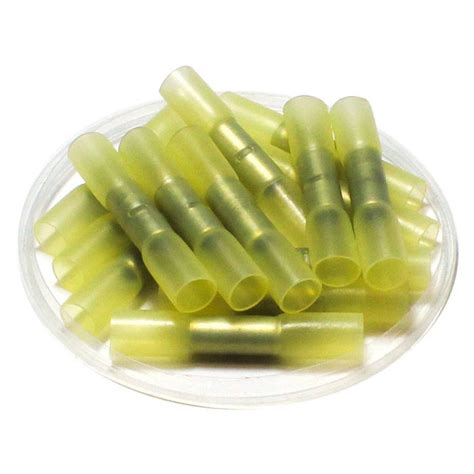Heat shrink connectors have become a ubiquitous component in various industries, including electronics, automotive, and aerospace, due to their reliability, ease of use, and versatility. These connectors utilize a heat-activated shrinkage process to establish a secure, waterproof, and electrically insulated connection between wires or cables. The process involves placing a heat shrink tube over the connection point, which then shrinks when exposed to heat, forming a tight seal around the joint. This technique provides excellent protection against environmental factors such as moisture, dust, and extreme temperatures, making heat shrink connectors an essential choice for applications where reliability and durability are paramount.
The development and widespread adoption of heat shrink connectors can be attributed to the need for efficient, cost-effective, and reliable methods for connecting and insulating electrical conductors. Traditional methods, such as soldering or using electrical tape, often presented issues with durability, water resistance, and the potential for electrical shorts. Heat shrink connectors address these challenges by offering a simple, yet robust solution that can withstand a wide range of environmental conditions. Moreover, advancements in materials science have led to the creation of heat shrink tubes with various properties, such as different shrink ratios, insulation materials, and adhesive-lined tubes for enhanced sealing capabilities.
Key Points
- Heat shrink connectors provide reliable, waterproof, and electrically insulated connections.
- They are used in various industries, including electronics, automotive, and aerospace.
- The connectors utilize a heat-activated shrinkage process to form a secure seal.
- They offer protection against environmental factors like moisture, dust, and extreme temperatures.
- Heat shrink connectors are a cost-effective and efficient method for connecting and insulating electrical conductors.
Types and Applications of Heat Shrink Connectors

Heat shrink connectors come in a variety of types, each designed to meet specific application requirements. One of the primary categorizations is based on the shrink ratio, which determines how much the tube will shrink when heated. Common shrink ratios include 2:1, 3:1, and 4:1, with the choice depending on the size of the wire or cable being connected. Another important factor is the material of the heat shrink tube, with options ranging from general-purpose polyolefin to more specialized materials like fluoropolymer or silicone, each offering unique properties such as flexibility, chemical resistance, or high-temperature stability.
In terms of applications, heat shrink connectors are widely used in the automotive industry for connecting wires in harsh environments, such as under the hood or in exterior lighting systems. They are also found in aerospace applications, where the reliability and resistance to extreme temperatures and vibrations are critical. The electronics industry utilizes heat shrink connectors for a variety of purposes, including connecting components on printed circuit boards (PCBs) and protecting solder joints from environmental stress. Additionally, heat shrink connectors play a crucial role in industrial control systems, telecommunications equipment, and medical devices, where the integrity of electrical connections is vital for safety and performance.
Technical Specifications and Selection Criteria
The selection of heat shrink connectors involves considering several technical specifications to ensure that the chosen connector meets the requirements of the application. One key factor is the operating temperature range, which can vary significantly depending on the material of the heat shrink tube. For instance, polyolefin tubes typically have a lower operating temperature range compared to fluoropolymer or silicone tubes. Another important consideration is the voltage rating, as heat shrink connectors are designed to withstand specific voltage levels without compromising the insulation properties.
| Material | Shrink Ratio | Operating Temperature Range | Voltage Rating |
|---|---|---|---|
| Polyolefin | 2:1, 3:1 | -40°C to 125°C | 600V |
| Fluoropolymer | 2:1, 4:1 | -55°C to 200°C | 1000V |
| Silicone | 3:1 | -50°C to 250°C | 800V |

Installation and Safety Considerations

The installation of heat shrink connectors requires careful attention to detail to ensure a reliable and safe connection. The process typically involves preparing the wire or cable ends, sliding the heat shrink tube over the connection, and then applying heat to shrink the tube. It’s essential to follow the manufacturer’s instructions for the specific heat shrink connector being used, as the recommended heating time and temperature can vary. Additionally, the use of a heat gun or other heating tool designed for this purpose is recommended, as it provides better control over the heating process compared to open flames or other makeshift heating methods.
Safety considerations are also paramount when working with heat shrink connectors. The heating process can generate high temperatures, posing a risk of burns or fires if not managed properly. It's crucial to work in a well-ventilated area, away from flammable materials, and to use protective gear such as gloves and safety glasses. Furthermore, ensuring that the heat shrink connector is fully shrunk and forms a tight seal around the connection is vital for preventing electrical shorts or other safety hazards.
Future Developments and Trends
The field of heat shrink connectors is continually evolving, driven by advancements in materials science and the demand for more reliable, efficient, and environmentally friendly solutions. One of the emerging trends is the development of bio-based heat shrink materials, which offer a more sustainable alternative to traditional petroleum-based products. Another area of research is the integration of smart materials into heat shrink connectors, enabling real-time monitoring of the connection’s integrity and performance. As industries move towards more complex and interconnected systems, the role of heat shrink connectors in ensuring the reliability and safety of electrical connections will continue to grow.
What are the primary advantages of using heat shrink connectors?
+The primary advantages include reliability, ease of use, and versatility, along with excellent protection against environmental factors such as moisture, dust, and extreme temperatures.
How do I choose the right heat shrink connector for my application?
+Consider factors such as the operating temperature range, voltage rating, shrink ratio, and material properties to ensure the connector meets the specific requirements of your application.
What safety precautions should I take when installing heat shrink connectors?
+Work in a well-ventilated area, use protective gear, and follow the manufacturer's instructions for heating times and temperatures to avoid risks of burns, fires, or electrical hazards.
In conclusion, heat shrink connectors have become an indispensable component in modern electrical connections, offering a reliable, efficient, and cost-effective solution for a wide range of applications. By understanding the technical specifications, installation procedures, and safety considerations associated with heat shrink connectors, professionals can leverage these components to enhance the performance and reliability of electrical systems. As technology continues to advance, the development of new materials and smart technologies will further expand the capabilities and applications of heat shrink connectors, solidifying their position as a critical element in the future of electrical engineering.



